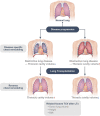Changes in Thoracic Cavity Volume After Bilateral Lung Transplantation
- PMID: 35721055
- PMCID: PMC9204381
- DOI: 10.3389/fmed.2022.881119
Changes in Thoracic Cavity Volume After Bilateral Lung Transplantation
Abstract
Purpose: End-stage lung diseases result in anatomical changes of the thoracic cavity. However, very few studies have assessed changes in the thoracic cavity after lung transplantation (LTx). This study aimed to evaluate the relationships between thoracic cavity volume (TCV) changes after LTx and underlying lung disease.
Methods: We reviewed 89 patients who underwent a pre-LTx pulmonary function test (PFT), chest computed tomography (CT) scan, and 1-year follow-up CT after LTx. These patients were classified into two groups according to pre-LTx PFT as follows: obstructive group [forced expiratory volume in 1 s (FEV1)/forced vital capacity (FVC) ratio < 70%] and restrictive group (FEV1/FVC ratio > 70%). We measured TCV using CT scan before and at 1 year after LTx and compared the TCV change in the two groups.
Results: In the restrictive group, TCV increased after LTx (preop: 2,347.8 ± 709.5 mL, 1-year postop: 3,224.4 ± 919.0 mL, p < 0.001). In contrast, in the obstructive group, it decreased after LTx (preop: 4,662.9 ± 1,296.3 mL, 1-year postop: 3,711.1 ± 891.7 mL, p < 0.001). We observed that restrictive lung disease, taller stature, lower body mass index, and larger donor lung were independently associated with increased TCV after LTx.
Conclusion: The disease-specific chest remodeling caused by restriction and hyperinflation is at least, in part, reversible. After LTx, the chest remodeling appears to occur in the opposite direction to the disease-specific remodeling caused by the underlying lung disease in recipients.
Keywords: chest wall remodeling; lung transplantation; obstructive lung disease; restrictive lung disease; thoracic cavity volume.
Copyright © 2022 Yu, Park, Paik, Lee, You, Shin, Jung and Haam.
Conflict of interest statement
The authors declare that the research was conducted in the absence of any commercial or financial relationships that could be construed as a potential conflict of interest.
Figures





References
LinkOut - more resources
Full Text Sources

